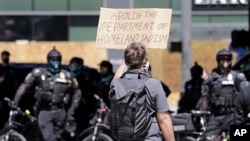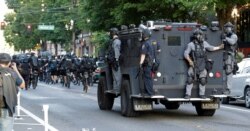A Seattle judge’s decision to compel The Seattle Times and four local television stations to turn over unpublished photos and videos from Black Lives Matter protests to the police is raising new questions about news media independence and credibility.
On July 23, King County Superior Court Judge Nelson Lee ruled in favor of the city’s police department in forcing the outlets to comply with a legal request filed last month over protests that turned violent on May 30.
Special laws called "shield" laws are designed to protect journalists from most of these requests, with exceptions for material critical to a criminal investigation. In this case, the judge said police needed the materials to identify suspects in open arson and gun-theft investigations.
Free press advocates say the ruling could set a dangerous precedent for First Amendment rights in the U.S. At least one other news outlet — Cleveland’s Plain Dealer — was served a similar request in June for material related to the protests.
Since 2017, when the U.S. Press Freedom Tracker started documenting attacks and threats to the media, authorities have subpoenaed or seized materials from 79 journalists. The Tracker is managed by the Press Freedom Foundation for a coalition of free-speech advocates, news organizations and journalism advocacy groups.
“I'm troubled by the judge's ruling,” Ken Paulson, director of the Free Speech Center at Middle Tennessee State University, told VOA. “They don't know what those photos and videos contain. It’s just speculation that it identifies anyone at all.”
Journalists are usually a help to protesters because news coverage brings the protest message to a wider audience, Paulson said. Moreover, the public spotlight can limit potential abuse by law enforcement, he said. But these types of rulings could alter those perceptions.
“What happens, as in this case, if protesters begin to think of journalists not as neutral observers but as an extension of the police?” Paulson asked. “When protesters see
journalists as working for the police, these media members' safety can be in danger.”
Madeline Lamo, a media litigation fellow at the Reporters Committee for Freedom of the Press, said the court ruling adds to the dangers of covering protests.
“Protests are already the most dangerous setting for journalists on the job in the United States,” she told VOA. “This only amplifies the danger that journalists are already in when they go to work at these events.”
The American Civil Liberties Union of Washington condemned the ruling in a July 23 statement.
“At a time when our basic freedoms are under attack, the City of Seattle should be doing everything possible to protect those foundational freedoms,” the ACLU said.
The case centered around whether the state’s shield law protects journalists from turning over information. Almost every U.S. state has a shield law, although protections vary.
Under Washington's law, journalists receive absolute protection from revealing information from confidential sources. For news or information that journalists gather in their reporting, it provides qualified protection allowing some to be disclosed through a subpoena, Lamo said.
A subpoena may be granted if the information is highly relevant to a case, if it is critical to proving a material issue to a claim or defense, if there is a compelling interest in the information, and if alternative ways to get the information are exhausted, Lamo said.
In his decision last week, Lee ruled that this request met all four criteria.
The judge placed limits, however, saying the police department could not use the video to pursue suspects in investigations unrelated to arson or gun theft. He also allowed only video from professional camera equipment, not reporters’ cellphones.
Before Lee’s ruling, the Reporters Committee filed a friend-of-the-court brief siding with efforts by the five news organizations to quash the request.
Michele Matassa Flores, executive editor of The Seattle Times, said earlier this month that the subpoena risked damaging the paper’s credibility.
“We don’t work in concert with government, and it’s important to our credibility and effectiveness to retain our independence from those we cover,” Matassa Flores said.
A decision on whether to appeal has not been made, a lawyer representing the news outlets said last week.








